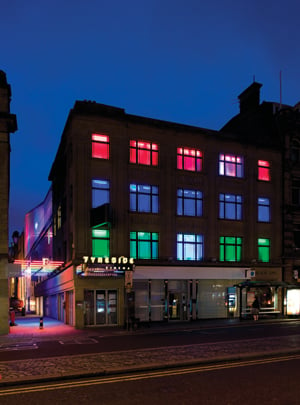Pixel Palaces in a digital kingdom?
A venue can become so much more than the sum of its parts if it opens up its spaces across artforms without sticking to definitions of what it is or should be, writes John Newbigin.

Manchester Cornerhouse sits on a corner of Oxford Street, Manchester. It’s obviously a café. You can see that from the street as you walk past. But it also has three cinemas. And two art galleries. And a bookshop with a specialist publishing imprint which sells around the world. Over the road are computer suites and digital editing studios, heavily used by young entrepreneurs, teachers and students, with a new hi-speed broadband connection to a pair of sister institutions, FACT in Liverpool, and the Tyneside Cinema in Newcastle. A couple of years ago Cornerhouse merged its cinema department with its visual arts department. Last year it merged education with marketing to create engagement (see p11). And now, according to its Director, Dave Moutrey, it is “merging everything”. It may even abandon the whole notion of having a programme and simply run an online wiki forum to let its users, artists and filmmakers decide what it does.
What’s happening at Cornerhouse is happening in half a dozen other English cities lucky enough to have similar cross artform venues (CAVs). All of them have their origins in the British Film Institute’s regional film theatres, the first of which opened its doors in 1967 at the Broadway Centre in Nottingham, and all maintain cinema at their heart, as part of the UK Film Council’s Digital Screen Network. But they have evolved to become pioneers of inter-disciplinary arts, digital experimentation, culture-led regeneration initiatives and innovative learning labs.
Cross-artforms cross-country
The Sheffield Showroom hosts the Sheffield Documentary festival and provides managed workspace for 50 small creative businesses, including Warp Films. The Tyneside Cinema is home to the AV Festival, the UK’s biggest international celebration of electronic arts. The Watershed on Bristol’s Harbourside is well known for its ‘Encounters’ short film festival, though perhaps less well known for its pioneering innovation lab, run jointly as a public interest company with Hewlett Packard, a major local employer. FACT in Liverpool is known internationally for its inter-disciplinary art commissions, but also runs ‘Tenantspin’ which gives Liverpudlians an opportunity to tell each other stories using film. The Broadway Centre in Nottingham is launching an annual ‘Screen Lit’ Festival in 2009 to celebrate the contribution that writers make to film, television and digital platforms. The Centre also provides managed workspaces that have made a crucial contribution to the regeneration of the city’s old lace-making quarter.
If the activities of the various centres are mixed then so too is their funding, which comes via a complex web of UK Film Council, Arts Council England (ACE), regional, local, European funding and commercial sponsorship and finance. Grants and sponsorship notwithstanding, all of them also earn a very substantial part of their living as straightforward commercial businesses. The obvious policy question they pose is this: are they just a handful of anomalies, evolutionary mutations thrown up by the haphazard history of successive governments’ funding priorities, or are they the first manifestations of something entirely new, in which the worlds of arts, culture, education and economic activity genuinely come together in new formations?
Blurring boundaries
A recent report entitled ‘Crossing Boundaries’, commissioned jointly by the UK Film Council, ACE and the Arts and Humanities Research Council, praised them as “critically important cultural intermediaries for the creative economy”. It also asked how they propose “…to realise the full potential of digital technology in overcoming physical and conceptual barriers and so pioneer the evolution of a truly national network of new practice in arts and culture”. The report’s authors – Tom Fleming Creative Consultancy – concluded that the six centres do indeed have the capacity to develop what they called “a reinvigorated and redefined cultural producer role”, and should get on with it.
As the CAVs now seek to build the partnerships necessary to achieve that ambition, they are naturally turning first to their existing practice of involving members and users in planning and programming. Can these energetic user groups provide the nucleus of a larger and more diffuse national network which spans the physical centres and virtual space? A tentative step was taken on this path with a two-day event at the Tyneside cinema in March this year entitled ‘Clicks or Mortar? Designing a future for cultural venues in the digital age’. A programme of screenings, performances, debates and installations was streamed live and was shaped and commented on by an army of Twitterers, Facebookers and e-mailers. The event was itself the culmination of a nine-month programme called ‘Pixel Palace’, and a parallel programme which allowed the Tyneside Cinema staff and trustees to travel the country forming new alliances and picking up new ideas.
Reality bites
One unsurprising conclusion of the Tyneside event was that the real and the virtual are interdependent. It was Clicks and Mortar rather than Clicks or Mortar; virtual engagement from around the country and across the world made the event richer, but its success also depended heavily on a well-equipped building with a superbly competent and techno-savvy staff team. Other events will follow and no doubt the relationship between clicks and mortar will become more sophisticated. With its emphasis on the importance of digital participation and skills, the Government’s ‘Digital Britain’ report gives added weight to a shift in public policy from thinking about the technical infrastructure of the digital world to its social, economic and cultural possibilities. The CAVs are well positioned as cultural pioneers of that future. Will they step up to the challenge? Watch this space.
Join the Discussion
You must be logged in to post a comment.